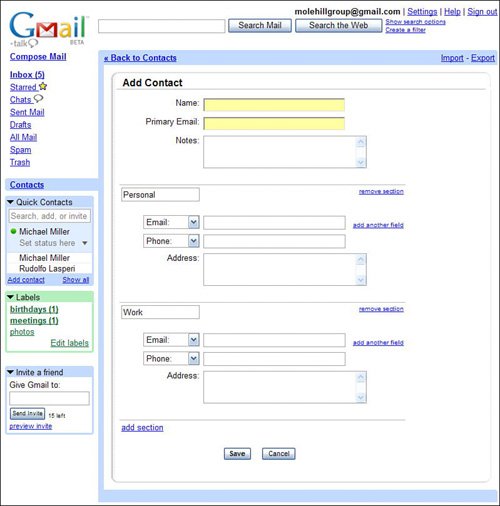Working with ContactsEvery email program or service offers some sort of address book, a list of your most-frequent contacts. Gmail is no exception; its Contacts list lets you store contact information (including but not limited to email addresses) for thousands of people. Even better, every time you send a message to a new email address, Gmail automatically adds that address to your Contacts list. Adding a New ContactAs I just said, Google automatically adds any email address to which you send a message to your Contacts list. You can also manually add contacts to your list by following these steps:
You can add even more information about a contact by clicking the Add More Contact Info link on the Add Contact page. This expands the page to include sections for phone number, address, and other information, as shown in Figure 21.22. You can even add your own custom fields and sections by clicking the Add Another Field and Add Section links, respectively. Figure 21.22. Adding additional contact info.
Importing Contacts from Another ProgramIf you already have a lot of contacts entered in another email program or service, such as Microsoft Outlook or MSN Hotmail (and you probably do), you can import those contacts into your Gmail Contacts list. All you have to do is export your contacts from the other program or service into a CSV-format file, and then import that file into Gmail. Tip You can also add a sender's email address to your Contacts list whenever you receive a new email message. All you have to do is open the message, click the More Options link, and then click Add Sender to Contacts List. For example, if you're using Microsoft Outlook as your primary email program, you start by selecting File, Import and Export (within Outlook), and then use Outlook's Import and Export Wizard to export your contacts into a Comma Separated Values (CSV) file. Once the CSV file is created, you follow these steps to import the contacts into Gmail:
Your contacts should now appear in Gmail's Contacts list. Displaying ContactsWhen you click the Contacts link on Gmail's inbox page, you display the Contacts list. There are three tabs within this list:
Click a tab to view the contacts within that tab. Note We'll talk more about groups in the "Using Contact Groups" section, later in this chapter. Searching for ContactsIf you have a ton of contacts in your Contacts list, you may need to search for the ones you want to use. To search for a particular contact, go to the Contacts list, enter the name of that contact into the search box, and then click the Search Contacts button. You can search by a person's first name, last name, or both; you can also search by domain or email address. Using Contact GroupsMost email programs let you create mailing lists that contain multiple email addresses, which makes it easier to send bulk mailings to groups of people. Gmail also offers a mailing listlike feature, which it calls contact groups. When you want to send a message to all members of a group, you only have to select the group namenot every contact individually. To create a contact group, follow these steps:
Sending a Message to a Contact or Contact GroupThe whole point of creating contacts and contacts groups is to make it easier to send email messageswithout having to remember all those email addresses every time. To that end, there are two ways to send messages to people or groups in your contacts list. Tip You can also add contacts to a group from either the Frequently Mailed or All Contacts tab. Just check the contacts you want to add, and then pull down the Add Contact To... list and select the name of the contact group. First, you can send messages directly from the Contacts page. Select one of the three tabs, check the name of the person or group you want to email, and then click the Compose button. This creates a new blank message, with that person or group's email address(es) already added to the To: line. Alternatively, you can click a contact's name in the Quick Contacts box, located on the left side of the Gmail page. As you can see in Figure 21.26, the Quick Contacts box lists those contacts with whom you've recently communicated, and also lets you search for people in your contacts list. When you click a contact name, a separate window opens with a new blank message displayed. Figure 21.26. Gmail's Quick Contacts box.
|